
Levinsky Gallery, University of Plymouth
29 September 2020 – 24 January 2021 (Due to the UK government's guidance regarding Covid-19, The Levinsky Gallery is closed until 2 December 2020.)
by DAVID TRIGG
Kehinde Wiley is well known for his vividly patterned portraits that subvert historical depictions of power, taste and privilege. Working in a hyperreal style, the Nigerian-American painter collides old master painting and rococo excess with a hip-hop sensibility to challenge the marginalisation of people of colour in the western artistic canon. His portraits, which switch the wealthy white Europeans of art history for contemporary black figures plucked from the streets, have won worldwide acclaim; in 2017, he was invited to paint the official portrait of the former US president Barack Obama for the Smithsonian National Portrait Gallery. This exhibition at Plymouth’s Levinsky Gallery, however, provides an opportunity to experience another side of Wiley’s practice: his first foray into film.
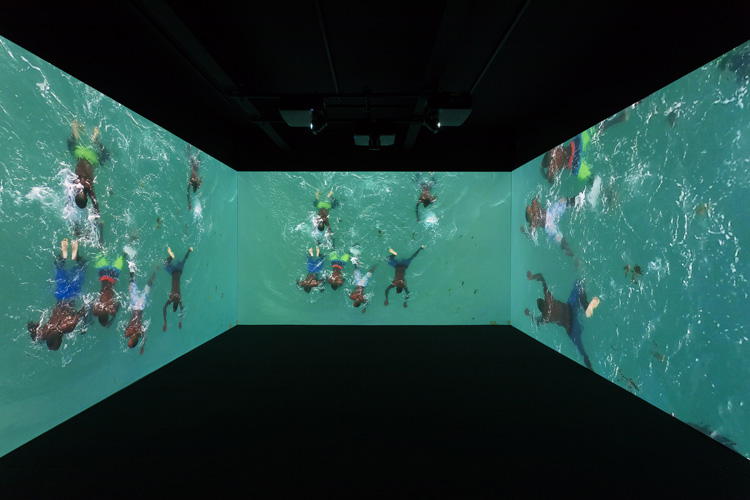
Kehinde Wiley, Narrenschiff, 2017. Three-channel projection, installation view, Levinsky Gallery, University of Plymouth, 2020.
Narrenschiff (2017) is an immersive three-channel projection that takes Sebastian Brant’s illustrated satire The Ship of Fools (1494) as its starting point. Brant’s book – one of the most important works of 15th-century German literature – introduces readers to 109 fools, each with different shortcomings, who travel together on a ship. His crew of fools lampoons politicians, clerics and others in society with an irreverent wit. Wiley’s 16-minute film, however, shows no trace of satire. A group of black men are shown swimming in the ocean, struggling to reach land. One scene features closeup headshots of individual figures bobbing in the water; another takes an overhead view, following the men as they glide together through the lush aquamarine sea. The group eventually reach dry land as waves break on the sandy shore.
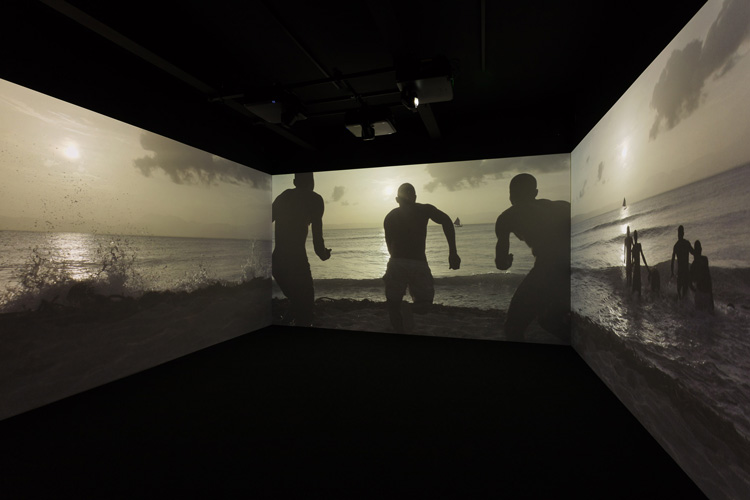
Kehinde Wiley, Narrenschiff, 2017. Three-channel projection, installation view, Levinsky Gallery, University of Plymouth, 2020.
On one level, Narrenschiff is an elegant study of black bodies in water. Wiley’s camera lingers on physiques and faces, and becomes captivated by light shimmering on the water. Images are repeated across the three screens, emphasising the subjects’ formal qualities. But these beautifully shot scenes are accompanied by sobering extracts from Frantz Fanon’s influential anti-colonial text The Wretched of the Earth (1963) and Michel Foucault’s seminal study Madness and Civilization (1964). Read by the actor CCH Pounder, the texts touch on colonial prejudice, mental health and the marginalisation of those who do not fit societal norms. Yet Wiley avoids any overt didacticism; his themes wash in and out like the on-screen waves, mixing with Maxim Budnick’s haunting score for piano and cello to create a poignant meditation on historical and contemporary histories of migration, exclusion and social dislocation.
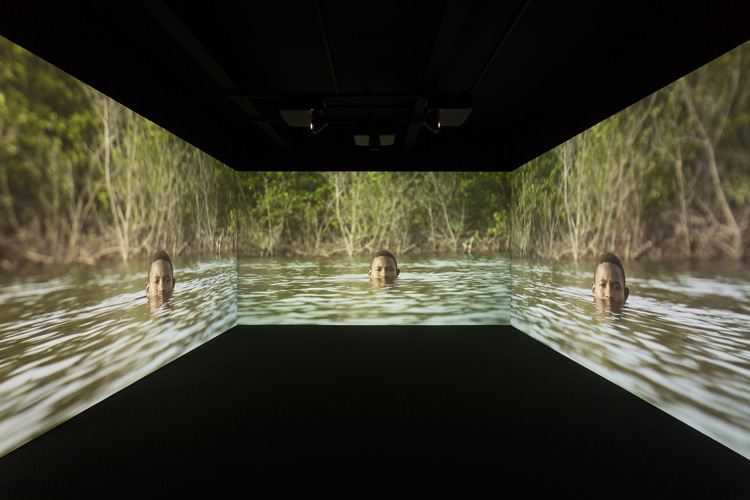
Kehinde Wiley, Narrenschiff, 2017. Three-channel projection, installation view, Levinsky Gallery, University of Plymouth, 2020.
A copy of Brant’s richly illustrated book – which was itself inspired by the allegorical ship and dysfunctional crew described by Plato in his Republic – is displayed in the dimly lit gallery. Whereas Plato intended to critique the notion of democracy, Brant ostensibly wanted to cultivate wisdom and reason in his readers. For Wiley, however, Brant’s tale is rooted in reality. As the gallery wall text boldly declares: “The Ship of Fools is not an imaginary story. In 13th-century western Europe, large numbers of people, who were labelled as outsiders, were made to set sail and forced into isolation and sometimes, as a consequence, sanatoriums.” This assertion derives from Foucault’s statement in Madness and Civilization that there was indeed a real-world counterpart to Brant’s Narrenschiff. But while there are historical examples of mad people travelling in boats along European rivers during the middle ages – whether expelled by towns or simply journeying to religious shrines in search of healing – there is scant evidence to suggest that the mentally ill were rounded up wholesale, placed in ships and delivered to sanatoria.1
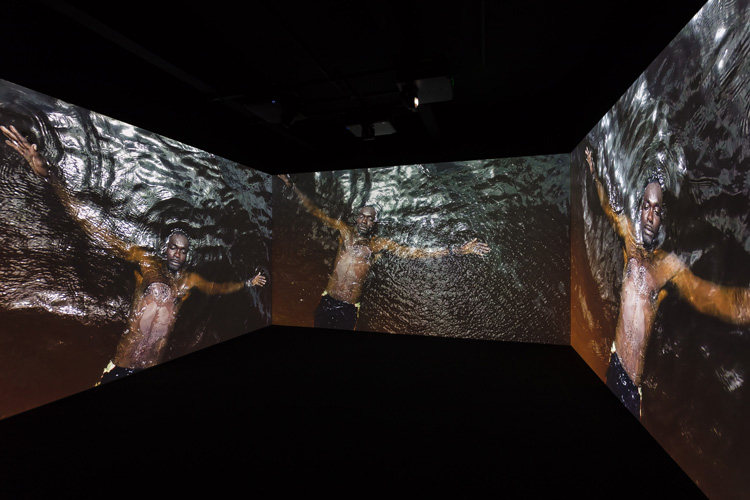
Kehinde Wiley, Narrenschiff, 2017. Three-channel projection, installation view, Levinsky Gallery, University of Plymouth, 2020.
While Foucault’s book is foundational in the study of otherness, the ship of fools remains a literary and artistic trope. The prejudice it reveals, however, is very much still in evidence and Wiley reinforces its relevance to considerations of colonialist legacies as well as contemporary issues surrounding migration in Europe and the US. The small boats and crews that navigate the waters of Narrenschiff appear small and fragile against the ocean, a vast body of water that, as the voiceover states, “carries off, but also purifies”. The sea can be understood here as a metaphor for physical and mental separation, but also as a conduit for new beginnings. Indeed, Narrenschiffis tinged with hope. The setting sun casting its glow over the water reminds us that the end of one day ushers in the dawn of another – as Wiley’s figures reach dry land, there is the possibility of a new start.
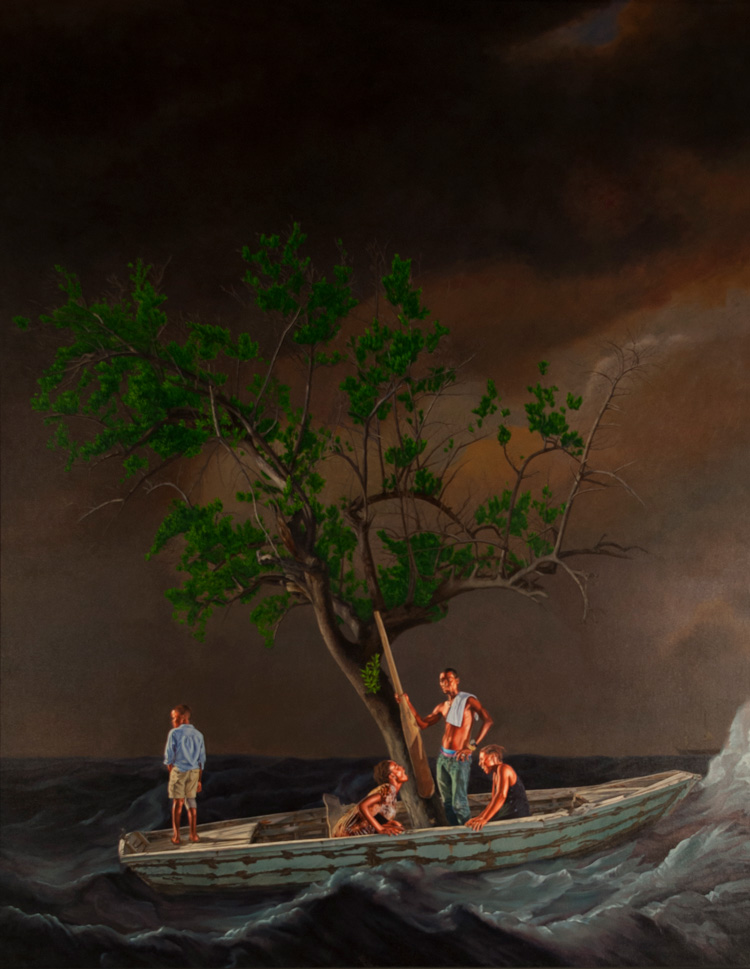
Kehinde Wiley, Ship of Fools, 2017. Oil on canvas, 272.4 x 222.5 cm ((107 1/4 x 87 5/8in). © Kehinde Wiley, courtesy of Royal Museums Greenwich.
Also on display is the 2017 painting Ship of Fools, a reimagining of Hieronymus Bosch’s mysterious painting of the same name (c1490-1500) in which a strange group of people appear adrift in a boat with a leafy tree for a mast. Wiley’s version shows a smaller group of black figures adrift on a stormy sea. The mast of their battered boat is similarly replaced by a large tree and we are reminded of the perilous sea crossings made by migrants and refugees the world over. But these travellers seem relaxed and unperturbed by their situation. Two women in the foreground laugh and joke as a young boy stands on the stern, staring fearlessly at the swelling waves; a man, standing oar in hand, looks more as if he is posing for an aspirational clothing brand than navigating dangerous waters. Strength in the face of adversity may be the subtext, but Wiley’s photographically derived figures appear contrived. As with many of his paintings, they are rendered in a fastidious, tightly controlled manner, lacking the depth and sensitivity found in the work of masters such as Bosch.
Wiley’s controlled paint handling is contrasted sharply by the fluidity and movement of Narrenschiff – a triumphant experiment in moving image that expands the artist’s practice, transporting it into new, refreshing territory. There is no doubting Wiley’s proficiency as a portrait painter, although, as this exhibition demonstrates, his skills are not limited to brushes and canvas. Narrenschiffmay be the first time the artist has dipped his toes into the world of film-making, but it should not be his last.
Reference
1. See Shipping Fools: Foucault’s Wandering Madman and Civic Responsibility in Late Medieval Germany by Anne M Koenig, Journal of Social History, Volume 54, Issue 1, Fall 2020, pp 125-160.
New paintings by American artist, Pat Steir, now 87, make their debut in this exhibition in Zurich...
Lubaina Himid with Magda Stawarska: Another Chance Encounter
Drawing on correspondence between the writer Sophie Brzeska and the artist Nina Hamnett as well as H...
Collaborating with craftspeople from around the world, Seulgi Lee incorporates traditional technique...
Mika Rottenberg – interview: ‘I’m not an angel or a political activi...
The multidisciplinary artist Mika Rottenberg talks about her first solo exhibition in Spain, at Haus...
Berlin. Cosmopolitan: The Vanished World of Felicie and Carl Bernstein
This small but insightful show puts the spotlight on a microcosm within Berlin’s art world at the ...
Emma Talbot – interview: ‘I imagine the experience of life as an epic...
Large installations, paintings on silk, fabric sculptures and drawings convey the connection between...
To mark its 40th birthday, Ditchling Museum of Art + Craft is hosting an exhibition all about reachi...
Mike Nelson: Humpty Dumpty, a transient history of Mardin earthworks low r...
From the architecture of an old hilltop city in Turkey to the demolished Heygate Estate in south Lon...
Jenny Saville: The Anatomy of Painting
Jenny Saville: This astounding show brings together the very best of an incomparable artist: absorbi...
From a mother bathing her children to cleaners working at the gallery, Margaret Salmon gives voice t...
Slavs and Tatars: The Contest of the Fruits
Rapping fruit, legendary birds and nail art feature in the UK debut of the Berlin-based collective S...
Liverpool Biennial 2025: Bedrock
From Sheila Hicks’s gemstone-like sculptures to Elizabeth Price’s video essay on modernist Catho...
Mikhail Karikis – interview: ‘What is the soundscape of the forthcomin...
Mikhail Karikis explains the ideas behind his new sound and video installation calling for action ag...
Art & the Book* and Spineless Wonders: The Power of Print Unbound**
Two concurrent exhibitions bring special collections into broader spaces of circulation, highlightin...
Focusing on the skills of wallpaper design and embroidery, this exhibition tells the story of the ...
Daphne Wright: Deep-Rooted Things
This show is a celebration of the domestic, and the poignant sculpture of Wright’s two sons, now o...
Anna Boghiguian: The Sunken Boat: A Glimpse into Past Histories
The venerable Egyptian Canadian installation artist Anna Boghiguian brings shipwrecks, shells and th...
Abstract Erotic: Louise Bourgeois, Eva Hesse, Alice Adams
A groundbreaking New York show from 1966 is brought back to life with the work of three women whose ...
Jeremy Deller – interview: ‘I’m not looking for the next thing. I...
How did he go from asking a brass band to play acid house to filming former miners re-enacting a sem...
Encounters: Giacometti x Huma Bhabha
The first of three exhibitions to position historic sculptures by Alberto Giacometti with new works ...
The Parisian scenes that Edward Burra is known for are joyful and sardonic, but his work depicting t...
The 36th Ljubljana Biennale of Graphic Arts: The Oracle
Surprising, thrilling, enchanting – under the artistic direction of Chus Martínez, the works in t...
It’s Terrible the Things I Have to Do to Be Me: On Femininity and Fame ...
In a series of essays about pairs of famous women, the cultural critic Philippa Snow explores the co...
Paul Thek: Seized by Joy. Paintings 1965-1988
A rare London show of elusive queer pioneer Paul Thek captures a quieter side of his unpredictable p...
This elegantly composed exhibition celebrates 25 years’ of awards to female artists by Anonymous W...
The first of its kind, this vast show is a stunning tour of the realism movement of the 1920s and 30...
Maggi Hambling: ‘The sea is sort of inside me now … [and] it’s as if...
Maggi Hambling’s new and highly personal installation, Time, in memory of her longtime partner, To...
Caspar Heinemann takes us on a deep, dark emotional dive with his nihilistic installation that refer...
Complex, multilayered paintings and sculptures reek of the dark histories of slavery and colonialism...
Shown in the context of the historic paintings of Dulwich Picture Gallery, Rachel Jones’s new pain...